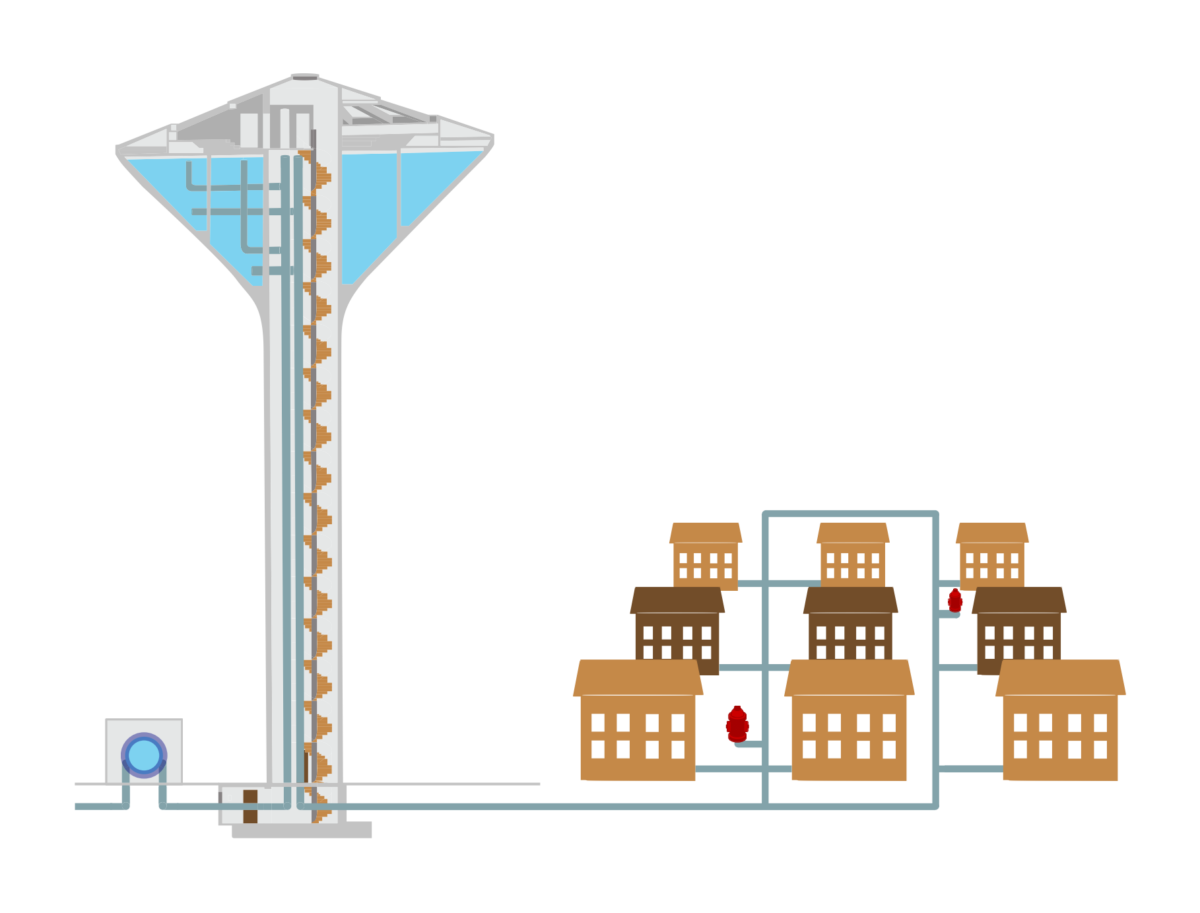On the Inside: How Does a Water Tower Function in a Water Distribution System?

Posted on January 23, 2024 by Brent Phillips
The primary purpose of a water tower is to provide consistent water pressure throughout the water distribution system. By storing water at an elevated height, gravity helps create the necessary pressure to push the water through pipes and into homes, businesses, and other establishments. It ensures community members have adequate pressure to access water for everyday activities such as drinking and cooking, washing clothes and dishes, showering, and other cleaning tasks.
Anatomy of a Water Tower: Understanding All the Components
Understanding the anatomy of a water tower is essential for anyone interested in civil engineering or water management. A water tower consists of several vital components that work together to ensure a reliable water supply to communities. In today’s blog, we’ll explore these critical components of a water tower.
- Water Tank Itself
- Support Structure
- Inlet Pipe
- Outlet Pipe
- Overflow Pipe
The Water Tank
The water tank is crucial in storing water to help with water pressure, whether used in residential homes or everyday business operations. A water storage tank can hold a specific volume of water and is constructed from different materials such as concrete, fiberglass, or steel. The size of the tank depends on the particular needs and requirements of the system it serves.
Support Structure
A water tower’s legs, also known as the foundation, provide the base upon which the entire structure rests. The foundation can withstand the weight and forces exerted on the tower, ensuring its structural integrity.
Additional structural supports can reinforce a tower’s stability. That can include braces, beams, or trusses that distribute the load evenly and prevent excessive movement or swaying in high-wind or seismic shifts in land movement.
Routine inspections and maintenance ensure the structural integrity remains in optimal condition. In defense of any signs of wear, damage, or deterioration should be promptly addressed to prevent tower collapse, human harm, or property damage.
Inlet Pipe
As the connection between the water supply line and tank, the inlet pipe’s role is to serve as the upstream flow of water into the water tank from its source. When filling the tank with water, the inlet pipe acts as a conduit, allowing water to enter the tank at an efficient rate or speed of flow without any overflow or leakage.
The water supply line often connects to a pressurized system, drawing water from a natural source such as a well, river, or reservoir. A pumping station uses various mechanisms like pumps and valves to transport water through the supply line into the elevated storage tank.
Outlet Pipe
The outlet pipe’s role is water distribution to consumer homes and business operations. It is an essential component that connects with water mains to deliver a steady water supply to meet water demand downstream.
The proper design and maintenance of the outlet pipe ensure efficient and reliable water distribution. It must handle the downstream flow and maintain adequate pressure throughout the system.
Overflow Pipe
The overflow pipe is a crucial safety feature in preventing the overfilling of tanks and ensuring the proper function of the system. It serves as an excess water drainage system, allowing any excess water to be safely diverted away from the tank.
Overfilling of tanks can lead to a range of issues, including:
- Damage to the Tank Itself
- Potential Flooding
- Safety Hazards
The overflow pipe is a safeguard by providing an outlet for excess water when the tank reaches its maximum capacity.
Diverting excess water through the overflow pipe helps optimize the tank levels to prevent damage or accidents caused by overfilling. The design and placement of an overflow pipe are critical factors in its effectiveness. It should be positioned at a height that ensures water will flow out when it reaches a certain level but also prevent:
- Constant Dripping
- Leaking During Normal Operation
- Backflow Problems
The Unsung Hero of Water Distribution Systems
In conclusion, water distribution systems are crucial in our daily lives, yet they often go unnoticed and underappreciated. These unsung heroes of infrastructure are responsible for ensuring clean and safe water reaches our homes, businesses, and public spaces.
Water management is a complex task that requires careful planning, maintenance, and monitoring. Public utilities are at the forefront of this effort, working tirelessly to ensure the efficient operation of water distribution systems. They invest in infrastructure upgrades, conduct regular inspections, schedule repairs and protective coating applications, and implement innovative technologies to optimize water usage.
With dedicated professionals helping water asset managers, these robust infrastructures succeed at providing all of us with access to clean water. That’s why the tank and tower experts at Cunningham Inc. want to recognize the efforts of water asset managers and support initiatives to improve water management practices.If your water assets are due for inspection or need maintenance, repair, or a new protective coating, please get in touch with the experts at Cunningham Inc. by calling (620) 848-3030.